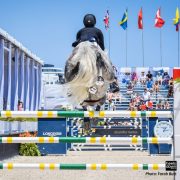Why I Don’t Do PPEs Anymore

What is a PPE? It stands for “Pre-Purchase Exam,” a fairly standard part of the horse buying and selling experience. When a rider is considering a horse available for sale, usually after they test ride it (or watch it go on video), they can have the horse evaluated by a veterinarian for general health and suitability for a particular job. Those findings can help a buyer make an educated decision on if this is the right horse for them. At least in theory, this is how the process goes.
But nothing about a proper veterinary exam is this black and white.
As someone who has bought, sold and owned off-track Thoroughbreds for the majority of my riding career, I’ve lost faith in the exam process.
This has nothing to do with the vets, who do honest, rigorous and often thankless work on behalf of the best interests of the horse. In these specific scenarios, all vets can do is take in how the horse is presented on that very day, in that very hour, and report back what they see. It lacks the context of training or the ground or turnout shenanigans of that day. They don’t know the horse’s history or personality. And as we’ve seen time and time again, even at the highest level of the sport, you “can’t ride the X-rays.”
While an exam by a medical professional with images of the current state of bones and soft tissue is highly valuable, especially as a baseline assessment, it will never tell the full story.
The problem with PPEs is not the process or the vet’s opinion, it lies in what buyers and sellers do with the information revealed in the exam. PPEs shouldn’t be treated as a “pass/fail” scenario. There is no animal bred for sport, with prey instincts and a mind of its own, that won’t have some type of blemish or conformational area of concern.
In the case of OTTBs, many retire from racing with injuries. And many, with previous injuries, go on to high-level second careers. Many have surgeries and go on to be jumped or galloped again. Many have kissing spines, and recover from routine surgery or are managed properly in their fitness work without issue.
My eventer has legs riddled with “track jewelry” – lumps and bumps and effusion all over. But with proper fitness, nutrition and routine care from our vet, body workers and farrier, he is sound, healthy and happy in his work. And no, I did not have a PPE done before I bought him. Nor did I do it on the last three horses I owned, all of which stayed sound until it was time to retire as they aged.
You can spend all the money you want imaging every part of a horse only to buy it and have it get hurt in the field, or the trailer, or its stall ,or in a storm on any day, at any moment in the future. Owning a pet – horse, dog, cat, you name it – comes with risk. Loving one comes with greater risk. Loving to compete on one, well, the risk just never goes away. At some point, if you want to be involved with horses, you just need to be OK with that.


